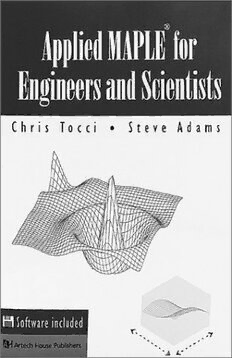Table Of ContentApplied Maple for
Engineers and Scientists
Applied Maple for
Engineers and Scientists
Chris Tocci Steve Adams
•
Artech House
Boston • London
LibraryofCongress Cataloging-in-PublicationData
Tocci,Christopher.
AppliedMaplefor engineersandscientists/ChrisTocciand SteveAdams.
p. cm.
Includesbibliographicalreferencesandindex.
ISBN0-89006-853-4(alk.paper)
1.Engineering mathematics—Dataprocessing. 2.Science—
Mathematics—Dataprocessing. 3.Maple(Computerfile) I.Adams, Stephen,
1959– . II.Title.
TA345.T63 1996
620’.00285’53—dc20 96-19492
CIP
BritishLibrary CataloguinginPublication Data
Tocci,Chris
Appled Maplefor engineersand scientists
1.Maple(Computerprogram) 2.Algebra—Computer programs
3.Engineering mathematics—Computerprograms
I.Title II.Adams,Steve,1959–
620’.00285’5369
ISBN0-89006-853-4
Coverandtextdesign by DarrellJudd
©1996ARTECH HOUSE,INC.
685Canton Street
Norwood,MA 02062
Allrightsreserved.Printedand bound intheUnitedStatesofAmerica.Nopartof this
bookmaybereproducedor utilizedinanyform or byanymeans,electronicor me-
chanical, including photocopying,recording,or byany informationstorageand re-
trievalsystem,withoutpermissioninwritingfrom thepublisher.
Alltermsmentionedinthisbookthatareknown to betrademarksor servicemarks
havebeenappropriatelycapitalized.ArtechHousecannot attesttotheaccuracyof this
information.Useof aterminthisbook shouldnotberegardedasaffecting thevalidity
of anytrademarkor servicemark.
International StandardBookNumber:0-89006-853-4
Libraryof CongressCatalogCardNumber:96-19492
10987654321
To mywife,Mercedes,my dad,Anthony,andthe ‘leggy’Woolfie
C.T.
To mylongsufferingwife,Fiona,and mydaughter,Sophie,whowillhaveto
leeratthisstuff
S.A.
AScpipelnietdis Mtsaplefor Engineersand
Contents
Foreword 1 More aboutMaple 5
Maple:atutorial 5
Help 6
Preface 1
Mapleasacalculator 9
Motive forusingthisbook 1 Mapleasaprogrammablecalculator 27
Who needs to use thisbook 2
Purpose ofthe book 2
Chapter 2
Philosophyofthe book 2
Chapter structureandorder 2 Active filter designand analysis 39
Case I:analoglow-passfilterdesign
Chapter 1 andanalysis 40
UseofLaplacetransformexplained 41
Introduction 1
Constituent relationships derived 41
Whatisa CAS ? 2 Designing a1-kHzButterworthLPF 47
Numbers 2 Bode magnitudeandphase plots 49
Symbols 3 Improvement on the 1-kHzButterworth LPF 53
vii
Applied Maplefor Engineersand Scientists
Butterworth LPFcomponent Chapter 4
sensitivityanalysis 55
Mathematical models:working with
Unequalresistance valuesin the Butterworth
differentialequations 133
LPFtopology 57
Butterworth LPFtest setup 60 ODE tools:a tour 134
Design iteration ofLPFsfor newerfiltering Thedsolvefunction 134
requirements 64 TheDEtoolspackage 137
Unitstep response 68 Thedifformspackage 143
Conclusion 70 Seriesmethods 144
CaseII:combfilter analysisanddesign 71
Modeling dynamic systems 152
Filter derivation andanalysis 72
Asimple shock absorber 152
Separating aknownsignalfrom aninterfering
Atwin massshock absorber 158
neighboring backgrounddesign 81
Anonlinearsystem 166
Cascading combfilters 87
Conclusion 91
Chapter 5
Chapter 3 Continuouscontrolapplication
theory 173
Curve fitting 93
Linear control systemanalysis 173
Introduction 93
Frequency-domain approach 175
Casestudy:Gaussian peakestimatorfilter
Partialfraction expansion 179
examplewith regressive curvefitting 95
Time-domain approach 194
Starting the Maple regression session 96
Time-invariantversustime-variantsystems 194
Linear regression using alogarithmic
Analysisofatime-invariant system:
representation ofthe Gaussianmodel 96
fundamentals 195
Problemdatasetfor linear regression 111
Thestatetransition matrix 200
Nonlinearregression:
Conclusion 210
the Levenberg-Marquardt algorithm 115
General polynomialregression 121
High-orderpolynomialregressionfit Chapter 6
problems 126
Quick moral about curvefitting 131 Discrete controlapplications 213
Conclusion 132 The pulsetransferfunction 215
Transformingcontinuoussignals 216
Calculatingthe timeresponse 234
State spaceequations andtheircanonical
forms 242
viii
Contents
Transferfunctionto statespace (thecontrollable Chapter 8
canonical form) 242
Switching topologies 301
Observablecanonicalform 247
Steady-statemethod 302
Pulsewidth modulator driver 302
Chapter 7
Switchingpowersupply 316
Discretedata processing 249 Fourier method 330
Maple plots 249
The plot structure 250 Appendix A 345
Imageconversion 252
Togreyscale 260
Appendix B 351
Normalize 263
Tofalsecolor 269
Conclusion 272 Glossary 357
Linearfilters 273
Differencing 273
About the authors 391
Moving average 276
Moving median 282
Exponentialfiltering 288 Index 393
Conclusion 296
ix
Applied Maplefor Engineersand Scientists
Foreword
A
bout7 yearsago, aftersome35years asa computational physi-
cist, I opened upmyfirst version of the computer algebrasystem
(CAS), Maple IV.Maple seemedtobeananswertomy needfor an
error-freeand fast systemto derive longinvolved algebra andcalculus solu-
tions.My delight turnedtoa somberrealizationthatMaple didnotreplace
allthe mathematicaland appliedmathematicalskills thatIhaddeveloped. I
stillhad tothink like a computational physicist and tolearnhowto use
Maple asa tool to extendmy capabilitiestoachieve solutions morequickly
andwithgreateraccuracy. Maple isnota mathematicianin a box!
My usualapproachtosolving,numerically, physics(andelectrical en-
gineering) problems using computers involved developing a sequenceof
models:
Physicsfi Mathematicalfi Numerical Analyticalfi Softwarefi Computer
xi
Applied Maplefor Engineersand Scientists
Each of these models represents an approximationtothe actual physi-
calprocess.Infact,the abovechain represented thesettingupof the prob-
lemfor a solution.The actual running of the solutionon a computer was
the trivial part.WhenI startedto use Maple IVto developfirst the mathe-
matical andthenthe software model, I realized I wouldhave tolearna new
languagetoeffectively use this tool. Ihadtorethink thewayIsolved the
problemof a mathematicalrepresentationofthe physicsor engineering
processI wastryingto solve.However,I hadno guide,nohandbook, no
MorseandFeshbach(MethodsofTheoreticalPhysics), thebiblefor mathe-
maticalphysicistsof mygeneration! So,I had tolearnby trying,byexperi-
menting. It was a longanddifficult process,especiallysinceMaple was
continuously being improvedand its capabilities extended. Afterseveral
years, I am stillnotfinishedwith this process.
However, Steve Adams and ChrisToccihave made the roadmuch
smoother andmorelevel withthis book,Applied Maple forEngineers
and Scientists. Setaround Maple V,Release4—thelatest version of this
software—they showhowto solvea varietyofproblems using Maple as
the principal tool.Ranging fromlinear activefiltersthroughcurvefitting
to ODEs,they showhowto set up theproblem usingMaple. Mostimpor-
tantly,evenif noneof the applicationscovered in thebook is germaneto
the reader’sspecific problems,Adams and Toccidemonstrate howan engi-
neer orscientistshould to thinkabouta problemwhenusing Maple as a
tool.
The authors donot leavethereaderhangingif they arenot already
proficientin Maple—they includea tutorialon Maple V,Release4,which
contains the principal featuresof this system.Ofequalimportance isthe
discussion of the physicsorengineering processesandof the important
mathematicalfunctions used ineachexample. These discussions, plusthe
plotting ofthe solutions using the Maple graphic engine,arecriticalele-
mentsin makingthis book analmost-self-containedreference andteaching
text.
ThomasN.Casselman
Casselman Computational Consultants(C3)
Dublin, CA
July1996
xii
Applied Maplefor Engineersand Scientists
Preface
Motive for using this book
M
aple is one of themostpowerful mathematics computeralge-
bra systems or computer algebrasystem (CAS)packageson the
markettoday.Consideringtoday’seconomic realities, it makes
perfect sensethatan initial indepth computer analysisof a quantitative
problemcould save manyperson-hoursandmaterialresource costs, hence
makingyou andyourorganizationmore competitive.Applied Maplefor
Engineersand Scientistswill get readersthinkingabouttheirspecific prob-
lems by using what the authorscall “template”applicationcase studies.
xiii

